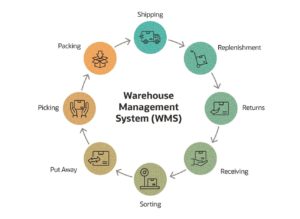
5 key factors to consider when picking a Warehouse Management System
This is how a warehouse management system can
tackle pain points in your supply chain.
Complaints about delayed or inaccurate shipments are not what stock managers want to hear every day. However, these pain points are bound to happen as customers increase their expectations, supply chains become longer and more complex, and capital costs rise to uncharted levels. A Warehouse Management System can get you through these hurdles, but there is a catch: actually picking one. Here are 5 key factors to consider to choose the right WMS for your business. Here is what you will learn:
What is a Warehouse Management System?
A Warehouse Management System (WMS) is a software solution that tracks materials and goods as they come in and go out of the warehouse. It is widely used in the manufacturing and retail industries, to provide visibility into the entire inventory and manage supply chains, from the distribution centre to the store shelf.

Source: Netsuite
These systems are specifically designed to support the needs of a large supply chain. When properly tailored to the needs of the company, they maximize labour, space utilization and equipment investments. WMS also allows companies to coordinate and optimize resource usage and material flows.
Stock management operations are generally invisible to the outside world, but they play a vital behind-the-scenes role. More than 30% of businesses admitted that unavailable stock prevented them from shipping orders on time. On average, warehouse capacity utilization is stagnant at less than 70%, meaning roughly one in every 3 square meters of warehousing is wasted. At the same time, warehouse rental costs reach all-time highs, in particular next to urban centers.
The right WMS also improves stock traceability. If something goes wrong with an item, you can easily check what else was in that batch and see if the issue persists. It is also extremely useful for handling incoming and outgoing products – you can scan and register as they come in and when they are shipped, adjusting stock levels appropriately.
On the other hand, a Warehouse Management System improves the reliability and accuracy of inventory levels. Manually writing or inputting data can cause huge problems in your operations, but a WMS makes sure that you see is what you have.
Put simply, WMS streamlines operations. But despite its many advantages and how long they have been in the market, WMS are far from ubiquitous. In fact, most business looking to adopt one or improve their current solution. According to Accenture, three out of every five companies are planning to adopt a Warehouse Management System as a result of the COVID-19 pandemic. It is not hard to see why: picking the right WMS takes time. For starters, it requires browsing through many existing alternatives and weighing the options against building your own custom solution. Whatever the chosen path, these are the 5 key features every WMS should possess.
5 key features every Warehouse Management System should have
When choosing the right Warehouse Management Software to manage your operations, look out for these 5 key features.
1. Automation
Automation is on top of every Warehouse Management Software requirements list. This feature ensures that warehouse operations run smoothly and actually save time. The software must be able to replace manual tasks, eliminating labour-intensive duties that involve repetitive work and manual data entry and analysis. Therefore, it reduces potential errors and ensures that data is updated and accurate.
2. Tracking and Monitoring
A good Warehouse Management Software is all about tracking and monitoring your goods as they go in and out of stock. With this feature, you can have a clearer visibility of your supply chain, and greater control over warehouse operations. Additionally, it is critical for warehouse space optimization. So, make sure your software offers advanced tracking, and barcode scanning so goods can be found easily when moved.
3. Customization
Every company has its own needs and demands. Hence, having a customizable Warehouse Management Software makes it easier for you to tailor it according to how you want it to be. Your Warehouse Management Software should reflect your own company, leave room to expand and customize key features such as product variables, manage users, add multiple locations, regions and currencies – to name just a few.
4. Flexibility and Accessibility
Changes keep coming. What wasn’t needed yesterday can become necessary today, as the COVID-19 pandemic taught us. At some point, you’ll have to adapt protocols, adjust operations and expand connections. That’s why it is important that your Warehouse Management Software can be can a long-term commitment that grows as your business does. You don’t want it to collapse under pressure. Also make sure that your WMS allows you to manage warehouse operations from any devices from anywhere, to keep things running – on your smartphone, tablet, or laptop.
5. Usability
Not everyone is tech-savvy enough to untangle new technology instinctively. Look for a Warehouse Management Software that is easy to understand, use, and set up, especially for beginners. In fact, if you don’t understand the data, it’s useless. Keep in mind that operational staff buy-in is key for implementation.
Near Partner on top of Warehouse Management Systems
With the right Warehouse Management System, you can face the future head-on. At Near Partner, we are ready to help you build your own software, upgrade legacy systems or recommend and customize best-in-class solutions. Let’s discuss your current operations and find ways to improve. Give us a call.





